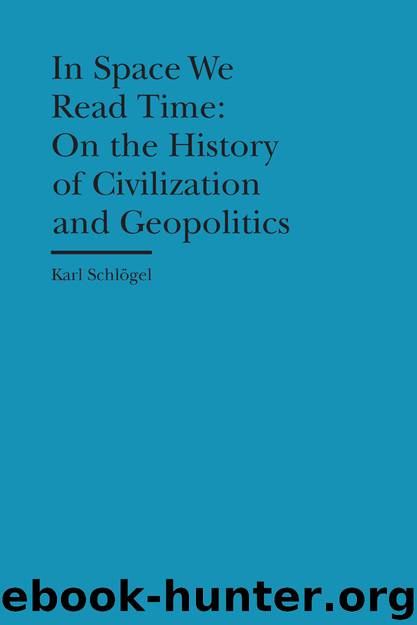In Space We Read Time by Unknown

Author:Unknown
Language: eng
Format: epub
Publisher: Bard Graduate Center
Reading Cities, City Maps
At first blush, the eye surrenders before the great city. It is too big, and there is no vantage point from which we might take it in at once. A series of metaphors from the natural world immediately suggest themselves: the city as a “sea of houses,” a “mountain range,” a “jungle,” even a “prairie”—that was the term Walter Benjamin chose, describing Moscow as a “prairie of architecture.”34 Most writers resort to the lexicon of the sublime to express the forbidding appearance of the city, its charm and its ineluctable spell. To behold the huge swell of brick and glass and concrete that is Manhattan, to look down into the canyons that are its avenues and streets: natural metaphors seem to be the form that lets humans cope with the majesty of an overwhelming spectacle, and the literature of the city is rife with them. An especially fine specimen appears in an essay by Alfred Döblin: “The cities are the principal home and seat of the human group. They are the coral colony for Man, the collective being. Is there any sense in opposing the country and the city? One can find weaknesses and dangers in the cities, can take sides in the battle of instincts at work in the cities. But one cannot reject or even evaluate the cities themselves, the foci of the social instinct.”35 The image of the city as a coral colony or reef that grows or shrinks, that is subject to different organic cycles and laws than those determined by the struggles and negotiations between antagonistic parties, encompasses both: its cell-like or molecular growth and its petrifaction, its sedimentation, the transmutation of “society” into “nature.”
In a way, to explore any city is to read its fossil record backwards. We know it is a coral colony, a structure that has a history but now appears rigidified and ossified, one from which life has fled but whose function and purpose are still legible in its face. That is why, complementing the natural imagery and the rhetoric of the sublime, there is a second discourse of the city that focuses attention on the rationality of its forms and undertakes to parse them. Wilhelm Heinrich Riehl, for example, interpreted “the city map as the ground plan of society” (his most salient example was the plan of Augsburg). The outward appearance of the city manifests its social structure as it has evolved over time. The basic assumption is that a congruence obtains between sociogeographical formation and the topographic situation, the urban landscape. The city is then the “mirror image of its social texture.”36 Across the centuries, the image of the urban landscape whose covert rationality awaits articulation by a knowledgeable observer appears in endless variation: from Thales of Miletus to Max Weber, from Aristotle to Lewis Mumford. They all give voice to a profound insight, one that is no less true for the fact that, like every truth, it can be reduced to triviality. The city is
Download
This site does not store any files on its server. We only index and link to content provided by other sites. Please contact the content providers to delete copyright contents if any and email us, we'll remove relevant links or contents immediately.
Kathy Andrews Collection by Kathy Andrews(11767)
The remains of the day by Kazuo Ishiguro(8895)
Spare by Prince Harry The Duke of Sussex(5142)
Paper Towns by Green John(5141)
The Body: A Guide for Occupants by Bill Bryson(5032)
Industrial Automation from Scratch: A hands-on guide to using sensors, actuators, PLCs, HMIs, and SCADA to automate industrial processes by Olushola Akande(5027)
Machine Learning at Scale with H2O by Gregory Keys | David Whiting(4261)
Be in a Treehouse by Pete Nelson(3999)
Never by Ken Follett(3885)
Harry Potter and the Goblet Of Fire by J.K. Rowling(3810)
Goodbye Paradise(3765)
Into Thin Air by Jon Krakauer(3349)
The Remains of the Day by Kazuo Ishiguro(3348)
Fairy Tale by Stephen King(3308)
The Cellar by Natasha Preston(3299)
The Genius of Japanese Carpentry by Azby Brown(3256)
120 Days of Sodom by Marquis de Sade(3227)
The Man Who Died Twice by Richard Osman(3042)
Drawing Shortcuts: Developing Quick Drawing Skills Using Today's Technology by Leggitt Jim(3040)
